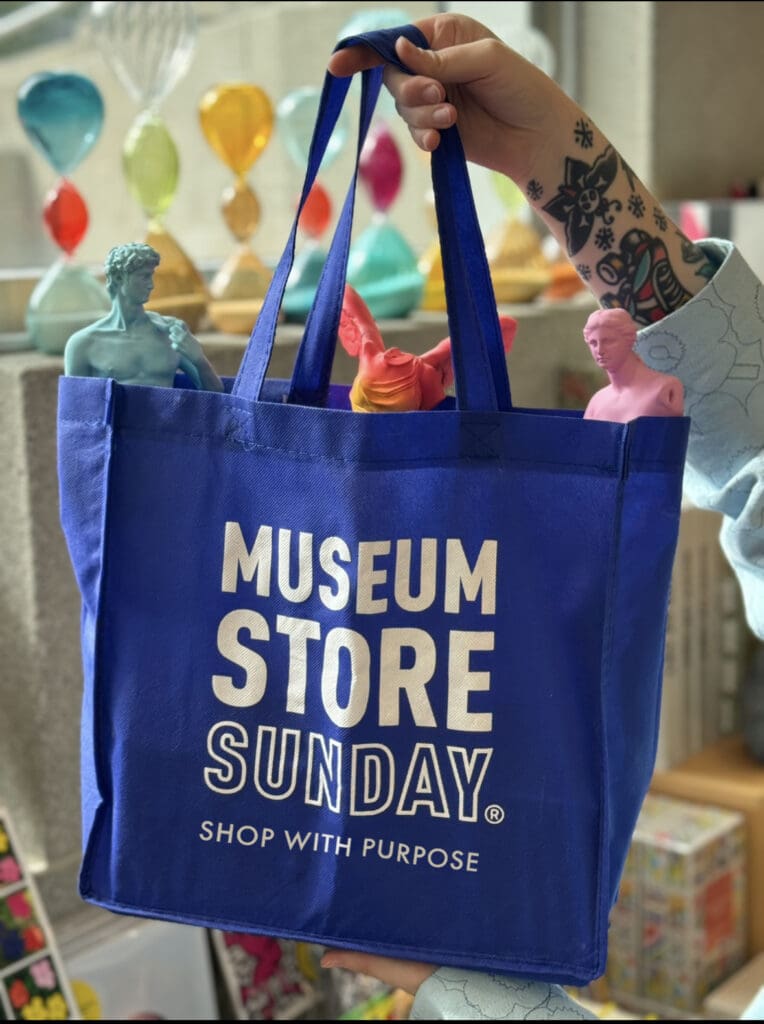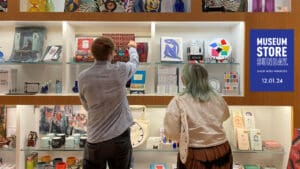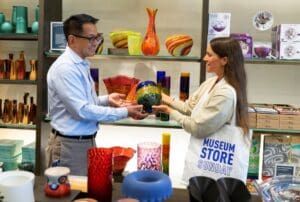
Image courtesy of the Mint Museum
RIDDLE
How many times can a single dollar be spent in one transaction?
ANSWER
At least six times if spent in a museum store:
It pays for a unique and meaningful item.
It buys education about a culture, technique, or museum object.
It supports the artist or small business that makes the item.
It provides employment for museum store staff.
It supports the programs and activities of the museum or cultural institution.
It is spent with purpose.
That’s a pretty valuable form of currency! Using it in nonprofit cultural stores invests in art, education, your community, and the preservation of our shared cultural heritage. Most of us work hard for our money and we are thoughtful about how we spend it. MSA’s global initiative, Museum Store Sunday, has a new tag line for 2024: Shop With Purpose. We know the value of shopping in a museum store, and we want to ignite our customers with that same sense of purpose. Stores and vendors are teaming up to focus on offering new product launches, discounts, trunk shows, and other programs to entice customers to come and engage in purposeful shopping. We all make purchases. Shopping in a museum store offers the opportunity to combine cultural support and education with the purchase of gifts, memories, research materials, and unique jewelry and accessories. Children’s products often feature toys, books, and games that make learning fun and accessible. These educational products can help foster a love for art, science, technology, or history in young minds, extending the museum’s impact beyond its physical walls.

Image courtesy of The Barnes Foundation
Purposeful purchasing supports art, science, history, and more while investing in the nonprofit institutions that preserve and protect our cultural heritage. Museum and cultural stores are uniquely positioned to offer high-quality, authentic products, both onsite and online, to consumers who care about supporting the cultural ecosystem. This sense of purpose drives them to bring the museum experience home, support vital institutions, and surrounds themselves and others with objects that spark conversations, pique curiosity, inspire research, and further a desire for education. This creates a connection to a wider world of art, science, history, and culture.
As museum professionals, it is our responsibility to communicate the importance and value of shopping with purpose to our customers. In stores, we see a fantastic job being done with attaching hangtags filled with content about the relationship of an item to the institution’s collection to products. There is great signage reinforcing this connection of purchases to institutional support. Images of objects in special exhibitions are often displayed next to a focused display of related products. Online stores use their pages effectively sending the same message of relatedness to consumers. While visiting the store in a museum, botanical garden, or performing arts center, the urge to shop purposefully is strong. The customer has been inspired by what they have experienced in galleries and engage in intentional shopping. We’re singing to the choir at this point. The challenge is to drive them to the onsite or online store to shop with purpose.

Image courtesy of de Young Legion of Honor
Shop With Purpose has valuable marketing potential. It walks right alongside the relatedness messaging. The message is full of stories and we all love a good story. Museum stores are full of carefully selected merchandise that reflect the institution’s collections, exhibitions, and missions. From elegantly designed and crafted jewelry inspired by ancient artifacts or fashioned after pieces worn in a portrait painting to scarves using details from images or artworks to books related to the collections with vivid illustrations and context. These stores offer a diverse array of products that cater to art enthusiasts, history buffs, and curious visitors alike. Museum and cultural stores are known for their commitment to quality and authenticity. To underscore this, some stores post the message that their product selections are curator-approved. Some items are exclusive collaborations with artists. Some are direct reproductions from the collections, others are interpretations. Some of the products inspire the STEAM brain and others are whimsical.
Museum stores often prioritize sustainability and ethical sourcing in their product selection. Institutions collaborate with artisans and fair-trade organizations to offer handmade goods that support traditional craftsmanship and provide fair wages to creators. Eco-friendly products are featured, from recycled/up-cycled materials to items that promote conservation efforts. By shopping at these stores, consumers can make environmentally conscious choices. All make a direct connection to the institution and its exhibits. This kind of careful and purposeful curation encourages customers to take away their museum experience, extending the impact of their visit long after they have left the galleries.
All of these products have a good story to tell in your marketing messages. The stories can be about the makers, the vendors that curate products for cultural stores, the relationship to the collections, and more. You know your own stories! That’s why you brought these products with their stories into your stores. When you reach outward to bring in customers to your onsite and your online store, use the power of this narrative-building and the message of how their purchase supports your institution’s programs to inspire them to shop with purpose. Help them understand how they can contribute to the cultural and educational strength of their community. Inspire them to channel their best intentions and motivations to be intentional in their shopping strategies. Make them feel like the partners they are in purposeful spending.
Shop With Purpose is a call to action. Museum Store Sunday will supercharge the holiday shopping in your stores. Use this tagline to catch the attention of consumers. The definition of purpose is to achieve a goal that’s both personally meaningful and makes a positive mark in the world. A sense of purpose often is other-focused, something that can improve the lives of others, something bigger than ourselves. Museum and cultural stores are uniquely positioned to fulfill those goals and uplift our customers to be purpose partners.
Purpose moves people to strengthen our world.

Susan DeLand, DeLand Consulting
Susan DeLand is an experienced business advisor for nonprofits, cultural stores, and small for-profit companies. Susan designs, builds, and remodels retail stores and business infrastructure. She is the author and editor of several business books for MSA, author of an extensive series biographies of artists , authors, and historic persons, and regularly writes articles and blogs. Susan also produces and curates art exhibitions, in-person literary panels discussions, and virtual art tours with museums and artists around the world. Her upcoming program is “Art That Brings You to Your Knees.”
Learn more about Susan by visiting LinkedIn
